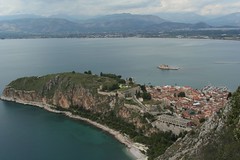
Click on pic to see slideshow
or here to access the Nafplion set
“3.60 Euro for Tzatziki? No, it’s too expensive; let’s look at the next taverna down the street.” Over the last few days we have worked out a system to pick restaurants for lunch or dinner – the tzatziki (a typical Greek bread dip made with creamy sheep yogurt, cucumbers and garlic) has to be under 3€ and the house red wine under 4€ for ½ liter. We drink wine by the liter in Greece and always the “house” variety, which, unlike in the United States, is a decent choice in most restaurants. The rest of our lunches and dinners typically consist of Greek salads (cucumbers, tomatoes, onions, olives and feta cheese), mousaka, souvlaki, gyros, loukaniki or other Greek meat specialties, and the ubiquitous French fries that accompany every Greek dish. For breakfast, unless it’s the simple choice that some hotels offer, we always have a cup of delicious yoghurt topped with honey and walnuts. Like the real tzatziki, the traditional plain Greek yoghurt is made with sheep milk, which is creamier, more consistent, and probably contains significantly more calories than the cow milk variety. I have not searched the specialty “gourmet” stores in Seattle, but this kind of yoghurt is not available in the grocery stores at home. In fact, in the US, the large stores usually carry one single brand of plain, unsweetened, yoghurt, and it’s often inedible. But I’m sure there must be some American Greeks somewhere, who have found a way to bring the flavors of their old home to the new continent…
Arriving in quiet, cobbled, manicured Nafplion, after the three weeks spent in chaotic Egypt, was a bit like waking up gradually from a dream and figuring out that the world still made sense. Nobody was harassing me, trying to get my money; nobody was insisting that I go to their shop. I was driving a car and all the roads were clearly marked in Greek and Latin letters. There was no garbage lying in the ditch by the road. The streets were quiet - it was November, after all. Traveling in Greece at this time of the year can be very convenient: the off-season hotel discounts are very enticing; often you pay the half of the rate the same rooms go for in high season. You don’t even need to reserve anything in advance, since the supply exceeds the demand by far. The weather is generally good for hiking and sightseeing (not for tanning, mind you), albeit a bit erratic – you may have to deal with alternating days of rain showers and beautiful skies. But Greece is also a country that would sober up any tourist who has travelled extensively in the third world – prices are, well… European, and this reflects best in the rates charged for internet access – they average around 4€ (about 6$) for one hour. Ah, where is Bolivia…
There was not much reason to go to any of the islands at this time of the year, so we stuck with the many historical attractions on the mainland. We picked up a rental car at the Athens airport and drove to Nafplion, a jewel of a sea-side town, with a pretty historical center of narrow streets, lined with tavernas and shops, dominated by the Palamidi fortress - a gigantic system of fortified walls built by the venetians on top of the hill overlooking the town, during one of the periods they ruled the place. Not far from Nafplion are the antique amphitheater at Epidavros (restored and used for festivals in summer) and the ruins of ancient Mycenae. With all good intentions, we tried to visit the city of mighty Agamemnon, but the new owners, the museum authority of Greece, were closing the place at 2:45pm in winter and we got there too late…
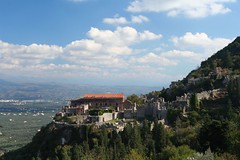
Click on pic to see slideshow
or here to access the Byzantine Towns set
The byzantine hill towns of the southern Peloponnese, Mystras and Monemvasia, tell a different history lesson. Although they are mostly in ruins now (Monemvasia however, has a few beautiful restored streets where tourists can sleep and spend money), they live on in the spirit of countless movies with medieval setting. Every fictional town built in terraces on the slopes of a mountain, with narrow, cobbled streets winding through stone gates, with houses and defensive walls hanging above rocky ravines, with an imposing fortress on the top of the hill, overlooking the valley, is in fact made up from the blueprint of these byzantine towns. They are quite interesting to visit, even if just to wonder what it would have taken to keep a city like that functioning – the sewers, the water supply, the transportation, the social life. It must have been nice to live in a town where every single house had a view…

Click on pic to see slideshow
or here to access the Delphi set
Back in antiquity and out of the Peloponnese, we stopped at Delphi to look for gods hidden among the scattered fallen column stones and the remnants of the once-glorious temples of Apollo and Athena. There were no gods, just tourists there – Delphi is nowadays the main day-trip destination of tour groups visiting Athens. But it was November and the invasion of tour buses was in minor key; even if the weather was beautiful, ideal for hiking up the slopes of Parnassus, there were so few other tourists around that I was able to take some pictures of the ruins without including people in them – such a feat would have been impossible in summer.
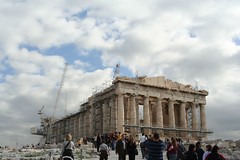
Click on pic to see slideshow
or here to access the Athens set
Finally, there was Athens – a big, dull, (and nowadays clean as well) city, where tourists get bored fast. The place is full of ancient history, but nevertheless, nobody falls in love with it. I didn’t either, but the food was good and the discovery of a Starbucks store in town made my stay sweeter. I went to the post office as well, but even if you count the fact that I went looking for it on the wrong street for a while (before realizing that it must have moved since the Lonely Planet book that I had was researched), the experience was nothing like the one in Egypt. Athens may not be glamorous or charming, but it has the incredible Acropolis, with its 25-century-old temples perched upon a craggy rock rising in the middle of the busy town, and that’s enough to keep you coming back. You have to stop here on your way to the islands anyway…
Published from Rome.


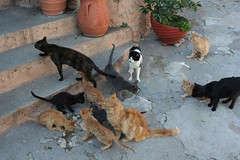
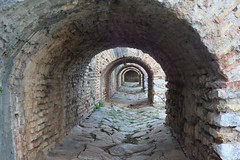

4 comments:
At our local "gourmet" grocery they sell greek yogurt.
That reinforces my belief that everything can be found in the US, if you only look for it... so why travel?
You travel so that you know what to look for when you get back to the US :)
Nice Post...
Live Stream users
Post a Comment